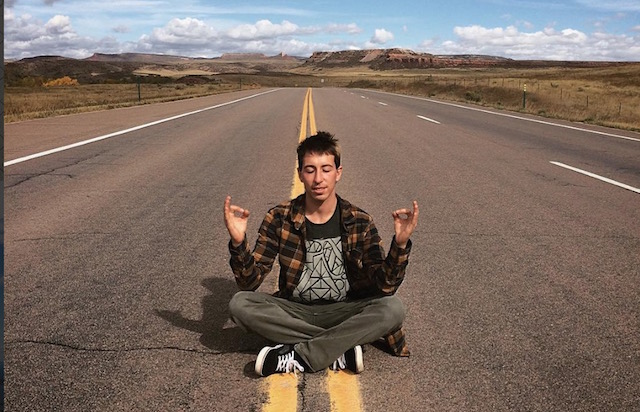![]()
Last year, I spent a month riding a moped around northern Thailand.
Propelled by a small 125cc motor, with only a creaking chassis between my legs to protect me from the tarmac rushing beneath and the sequence of fatal precipices awaiting just over the edges of the winding mountain roads, I was often acutely aware of the obvious dangers of my elected choice of travel.
But the anxiety soon abated. Long days of riding presented an opportunity for contemplation. At points, journeys fraught with heavy traffic, monsoon rain, and treacherous roads gave rise to a state comparable to meditation. Each uncertain leg of the journey was imbued with a Zen-like calm and awareness of each moment.

I was reminded of Robert M. Pirsig’s cult novel Zen and the Art of Motorcycle Maintenance, the two-wheeled philosophical romp tackling the nature of truth, mountain peaks, the Buddha, Zen, Tao, and the spirit of the road.
In its pages, the late Pirsig contemplates the sense of presence he experienced when riding for many weeks on a motorcycle across the United States. He also stumbled upon the mindful simplicity of riding on two wheels. “In a car you’re always in a compartment,” he writes. “You’re a passive observer and it is all moving by you boringly in a frame. On a cycle the frame is gone. You’re completely in contact with it all. You’re in the scene, not just watching it anymore, and the sense of presence is overwhelming.”
Pirsig’s ruminations are instructive in how riding on two wheels can become a meditation in itself. But Zen, it seems, can be discovered on a moped just as well as a motorcycle.
Riding a moped requires focus, awareness, and presence—a lot like meditation. In our day-to-day lives, we spend so much of our time lost in the thoughts of things that steal us from the present: the electricity bill that came through the post box this morning, last week’s difficult meeting at work, last year’s family argument around the Christmas tree.
On a moped, however, we can’t spend all our time concerned with what is happening behind us. If we spend all our time staring into the mirror, we’re going to lose sight of the road, miss the traffic ahead, and likely misjudge the next bend.
In the day-to-day, this is no different. If we spend all our time looking into the mirror and caught up in what has been, we miss the reality of what is.
On a moped, it’s imperative to look ahead. We need to look to the future to predict what is likely to happen so that we can react in time. We need to scope out what the truck in front of us is going to do next if we want to move around it to the empty road ahead with minimal hazard and disruption. We need to look as far round the approaching bend as we can to judge which line to follow, how much speed we should carry, and if we should slow down.
However, if we focus all of our awareness in the distance, we’d likely miss the pothole just ahead or that oil slick that would transform our blissful, upright ride into a jolting series of evasive measures to avoid total wipeout. An attitude of future orientation is important, but it shouldn’t occupy all our concentration. If we focus too intently on looking to a brighter future, we might miss the open doors of the present. We fail to see the woods for the trees, so to speak—or as Pirsig writes, “The truth knocks on the door and you say, ‘Go away, I’m looking for the truth,’ and so it goes away. Puzzling.”
The optimal conditions for riding have nothing to do with the weather, the state of the roads, or the meanness of the traffic. These things are out of our control, so we shouldn’t let them affect our frame of mind or the journey itself. The best rides are those when we’re aware of our breathing, present in the moment, connected to the stillness and calmness of the moment, even at 90 km/h. In these moments, we see and hear everything around us, without focusing too long on any one thing such that we become distracted.
The road is actually an apt metaphor for how to live our lives with the utmost presence.
On any journey, on any road, we can expect straight runs, steep gradients, tight corners, and long sweeping arcs. The trick of mastering two wheels is to approach all parts of the road and all styles of riding with the same mental approach that is clear and circumspect, pervaded by calmness, and characterised by a confidence that comes only through tenacious focus and consistent awareness. Mastery of any skill in our professional and private lives requires the same tenacity, clarity of awareness, and disciplined repetition.
Just like the road, there are unpredictable variables in life that we must wrestle with in order to pass beyond them. Some are serious—accidents, mudslides, and maniacal drivers—while some are less so—a sudden rain shower, wet leaves, or a pack of stray dogs.
For the journey to be one of smoothness and serenity, we must be constantly aware that the unexpected can happen at any time but not let that awareness reduce us to a state of impotent anxiety and quivering neurosis. We must have the quiet confidence to react and, once beyond the obstacle, to resume our journey with the same attitude as before.
We must engage with each moment, and then just let it go.
~
~
Author: James Pinnock
Image: Author’s own; @ian_boll/Instagram
Editor: Callie Rushton
Copy Editor: Travis May









Read 0 comments and reply